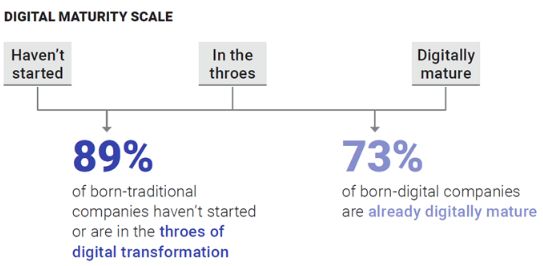Born-digital companies can be overtaken by newcomers edging into their markets—if they let their technology get stale. And they can get caught off guard by major disruptions—such as the COVID-19 crisis. The increase in remote work catalyzed by the pandemic prompted a revisiting of technology roadmaps.
To avoid the outdated-tech trap, companies must infuse discipline into their tech management processes and take a business-focused approach to keeping their tech current.By doing so, they can sustain the growth momentum they gained in their early years.
This article is part of our Born-Digital study, where AlixPartners set out to research born-digital companies' unique blend of strengths and challenges and identify the most pressing needs and areas of focus needed to sustain their success.
It's easy to assume that born-digital companies alwayshave the latest and greatest technology. But that's notnecessarily true. Indeed, we've found that technology is oneof the toughest areas for these businesses to keep up—perhaps because they feel committed to the breakthroughsthat launched them. Equally important, many technologiesare quickly and easily copied, so they don't, in themselves,provide a competitive advantage forever. In a strange irony,it's the very pace of technology change that can renderborn-digital companies obsolete as soon as even moreagile newcomers muscle into their markets.
Letting tech get out of date comes with a high price tag.For example, employees may lose valuable time thatthey could spend with customers or partners becausetheir internal systems are not up to date, sapping theirproductivity and agility. A company with outdated tech mayalso be more vulnerable to cyberattacks and data breaches.
But it doesn't have to be this way.
To avoid these pitfalls,born-digital companies will have to keep up with tech asthey age and put the right people in charge of their digitalstrategy. Moreover, they'll need to proactively correct theirmistakes as well as quickly beef up their digital capabilities.
Examples of companies that have excelled on this frontinclude Airbnb, which surmounted growth challengesaffecting its digital platform by launching a major initiativeaimed at reconstructing its warehouse and revitalizing itsdata engineering community.1 Similarly, to address issuesarising from rapid growth in demand for its services, fooddelivery and takeout company DoorDash established a platform strategy and roadmap focused on understandingand responding more effectively and efficiently to itscustomers' and its own immediate as well as longer-termdata needs.2
Most companies make extensive use of cloud applications:
- 70% born-digital companies
- 70% born-traditional companies
Keep up with tech updates
The good news is that born-digital companies in an array of industries possess the expertise to tackle sophisticated, complex technology challenges (for instance, automatic image recognition and fabric selection for fashion design). But, they have very little capacity to absorb unplannedshocks, such as an outage, cybersecurity breaches, and unexpected explosions in demand for their technology.
That's especially dangerous when these companies' entire business model and competitive advantage hinge on technology. True, born-digital enterprises are substantially more digitally mature than their born-traditional counterparts. But to keep up with tech as the company matures, they should invest in their digital platform to ensure that it is sustainable and continue strengthening their internal business systems to maintain their ability to grow.

Employees may lose valuable time they could spend with customers or partners because their internal systems are not up to date, sapping their productivity and agility
Put the right people in charge of your digital strategy
In born-digital and born-traditional companies alike, keeping tech current is essential to executing digital strategies. But even a brilliant digital strategy will fall flat if it's not led by the right people. In our study, born-digital companies said they trust the crafting and execution of their digital strategy to newer C-suite roles like chief technology officer and chief digital officer. Born-traditional companies, by contrast, rely more on the direct involvement of the CEO in this realm of strategizing. While it's critical to have CEO support, being the main driver of digital strategy comes at the expense of other essential responsibilities if left to the CEO.
What's more, many born-digital companies have a product or service that's based on technology. This situation can blur the line between having an internal IT strategy to support employees and an external digital strategy to serve customers. To sustain the advantage these companies gained early on, they need to integrate technology with their business processes—for example, by creating a single, integrated view of their customer, designing fully automated processes (such as order-to-cash), and using the data they have on hand to create a multichannel experience for customers. The newer C-suite roles are better positioned to orchestrate this integration.
60% of both born-digital and born-traditional companies report having a clear distinction between their IT strategy and digital strategy
Proactively correct your mistakes
Technology lifecycles are getting shorter; for instance, software updates on smartphones come just six months after the latest version was launched. Owing to their leading-edge nature, some born-digital companies made the wrong bets on early technologies that didn't pan out.
At the same time, they've underinvested in non-core functions such as customer service or finance. And that oversight has come back to haunt them. The mostforward-looking of these companies plug in best-in-class cloud-based services to handle outsourced functions like payroll management, to cover these other bases. They also combine their focus on innovation and revenue growth withattention to cost control through efficiency and automation. That's because they know that as they mature, their investors will concentrate on more balanced fiscal metrics, such as EBITDA, that are directly affected by cost.
Quickly beef up your digital capabilities
For born-digital companies seeking to recover from the wrong bets, or wanting to retool their approach to tech to stay current, what options do they have? Every situation and starting point is unique, of course. But our experiencewith clients suggests a general approach that works well for any company eager to jump-start or strengthen its digital capabilities.
Keys to success include viewing tech management through a business-centric lens—that is, linking technology moves to actual problems that the companyneeds to solve. We also advise building on a series of discrete successes, and progressively updating digital capabilities, versus making bet-the-company gambles.
This approach helps companies modernize outdated tech—with much lower risk and significantly shorter payback periods than big bang approaches deliver. Italso positions them to reinvent their business model and operating model as needed to keep pace with rapid advances in the technological and competitive landscape.
The result?
Born-digital companies sweeten the odds of future-proofing themselves. Consider Google. As the company matured and scaled, maintaining its technology edge became more challenging. Like any business characterized by a stronginnovation culture, not all new products took off (think Glass and Hangouts). To stay on top of tech as they scale, companies can strengthen digital capabilities in-house or acquire them from outside—or do both. With this inmind, Google launched a series of strategic M&A deals, ranging from Android OS, YouTube, AdMob, and ITA (a travel software tool) to Waze (the GPS navigation software app), DeepMind (an AI company), and Fitbit.3
Spotify, the music-streaming leader, is another case in point. 4 The company has sustained its growth through several savvy tactics. For example, it took a balanced approach to business partnerships. Understanding that streaming services technologies are easily replicated it forged an exclusive partnership with Facebook to become its default music service and then established similar deals with companies like Uber, Roku, and Android. Spotify also expanded its digital platform from a single application to a music service supported through browsers and mobile, thus broadening its user community. Finally,to differentiate its offering on the technical front, it has invested in advanced sound quality codecs and acquired music-personalization and discovery company Tunigo.
As these examples show, keeping tech up-to-date is no easy feat—even for born-digital companies. Meeting this imperative requires large doses of strategic thinking, along with the willingness and ability to launch major transformation programs. Enterprises that deploy the practices described here will stand the best chance of holding their position on the leading edge of technology—so they can flex in the future as their customers and competitors change.
How to update stale technology—quickly
If you've deployed an alternative digital platform in the cloud (Microsoft, Amazon, Google), use it as a blank-canvas technical foundation—regardless of your previous technology choices. Connect the platform to your existing systems, and extract the relevant data for your identified business problem into a data repository.
Pick the next set of projects to deliver. Use them to build anupdated digital services platform, delivery capability, and businessand collaboration model (especially with product teams).
Pick a critical business problem that can be addressed by updated digital capabilities in less than six months. Use this project to showcase digital's possibilities, agile delivery, dynamic decision-making, and actual results. And then repeat.
Use internal resources or partners to apply the relevant digital solution to address the business challenge as a project. Examples of such projects include building a chatbot, creating an app, automating a process, and adding sensors to your production line.
Footnotes
1 Integrate the digital technologies used in your organization withkey business processes to create new forms of value for customers.
2 Pay just as much attention to capturing cost savings through efficiencyand automation as you do to spurring innovation and revenue growth.
3 Forge business partnerships and advance your digital platform tokeep growing even if digital technologies you initially developed or adoptedare replicated.
4 Accelerate updating of your digital capabilities by usingtechnology to tackle specific business problems, score quick wins, andgain insights for launching additional digital projects.
Download the PDF, here
The content of this article is intended to provide a general guide to the subject matter. Specialist advice should be sought about your specific circumstances.





